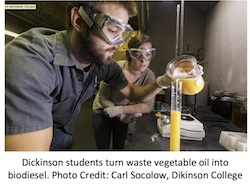 The U.S. Environmental Protection Agency (EPA) has awarded Virent fuel registration for its BioForm Gasoline in blends of up to 45 percent. As a registered fuel, Virent’s biogasoline can now be used in on-highway motor vehicles. According to Virent, BioForm Gasoline is a high octane, direct replacement fuel made from plants that offers the benefits of high performance and blend rates, complete compatibility with existing refining and distribution infrastructure networks and reduced carbon footprint.
The U.S. Environmental Protection Agency (EPA) has awarded Virent fuel registration for its BioForm Gasoline in blends of up to 45 percent. As a registered fuel, Virent’s biogasoline can now be used in on-highway motor vehicles. According to Virent, BioForm Gasoline is a high octane, direct replacement fuel made from plants that offers the benefits of high performance and blend rates, complete compatibility with existing refining and distribution infrastructure networks and reduced carbon footprint.
“Securing EPA registration of our BioForm Gasoline is further confirmation of Virent’s high quality drop-in fuel and is another step towards commercializing our technology to produce renewable fuels and chemicals from biobased feedstocks,” said Lee Edwards, CEO and President of Virent. “We would also like to recognize our longtime collaborator Royal Dutch Shell for supporting the registration and testing process.”
The BioForm Gasoline blended with conventional gasoline underwent testing at Southwest Research Institute (SWRI) with the results demonstrating that the emissions from the blended fuel were well below the maximum permitted by current regulations, according to Virent. The BioForm Gasoline was manufactured by Virent at its demonstration plant in Madison, Wisconsin, which is capable of producing up to 10,000 gallons of biofuels and biochemicals per year. The EPA testing work was funded by Virent partner Royal Dutch Shell.
Matthew Tipper, Shell Vice President Alternative Energies, added, “Shell is pleased to see continued progress of biofuels as a road transport fuel in the United States as evidenced by this most recent EPA registration of a plant-based alternative fuel. This success demonstrates the progress being made by the biofuels industry. Also, it supports a continuation of a framework for expanding commercialization and use of biofuels, including advanced biofuels produced from non-food based plant alternatives, in the United States.”











